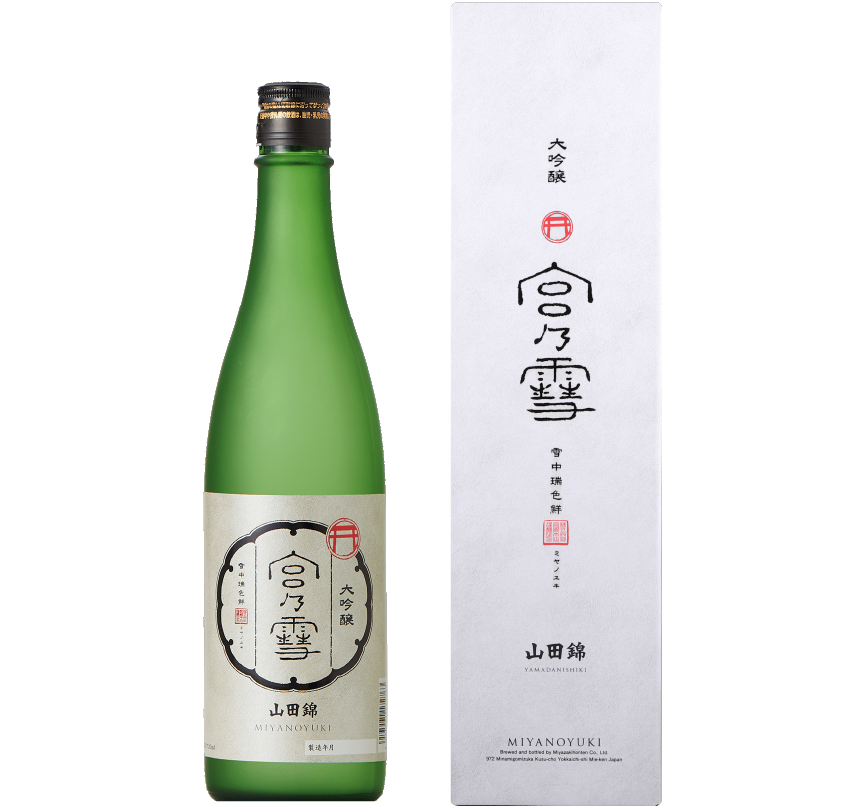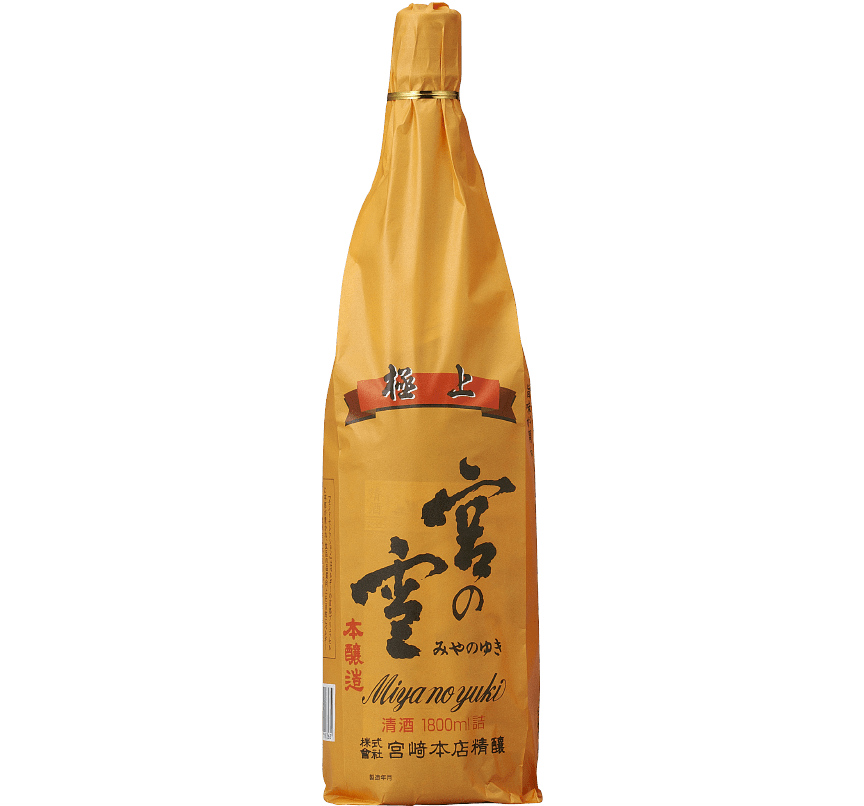Sake MIYANOYUKI
Glamorous aroma and
rice original rich flavor
Its name comes from 'miya (shrine)' after Ise Shrine sacred in Mie and our shop name, and 'yuki (snow)' covering the Suzuka mountains. Specialty Sake using Jyunmai Kobo (yeast) and homemade koji (malt), and fermented slowly and carefully.
It is a characteristic that your mouth will be filled with full-bodied aroma and rich sweetness and delicate sourness as soon as you take a sip. Good drinking feeling is smooth and refreshing, rich flavor of rice is brought out. You can enjoy clean flavor that you will not get bord of drinking.
MIYANOYUKI Jyunmai Daiginjo Tojo Yamadanishiki
Junmai Daiginjo-shu with the delicious rice flavor and delicate taste of Tojo-produced Yamadanishiki, the highest grade of sake rice.
It has a crystalline brilliance, with aromas of white peach, muscatel, and apple, and a soft mouthfeel with a rich, rice-derived richness.
Well chilled, it gives the impression of being a good aperitif.
About Tojo Yamadanishiki
Yamada-Nishiki, the king of sake rice, is highly regarded by sake brewers throughout Japan as the best rice for sake brewing, and the trademark was registered in 2009 to promote the branding of Yamada-Nishiki produced in the Tojo district of Kato-shi, Hyogo Prefecture, where the entire region is designated as a "Special A area".
The characteristics of the Tojo Yamadanishiki tinsel are 1) large grains and can withstand the high-definition rice yield. 2) Fewer proteins cause miscellaneous taste. 3) Water absorbency is good, and koji is easily activated.Therefore, good-quality koji can be produced.



MIYANOYUKI Jyunmai Daiginjo Tojo Yamadanishiki
Spicy flavor like clove and Nutmeg, and favorable splendid fragrance like melon and peach spread, and will be covered with fresh aroma like bamboo leaves. Elegant and thick sweetness but also precise sourness spread in the mouth. It is a deep flavor, which you can feel the well-balanced depth.
[best temperature for serving]
8 to 12 degrees Celsius. Served cold: very good
[Goes well with]
Gorgonzola cheese, prosciutto and melon, sea bass sashimi (with ponzu sauce)
[alcohol content]
16 percent
[volume]
720ml



MIYANOYUKI Jyunmai Daiginjo yamadanishiki
Splendid Ginjoko (ginjo fragrance) is its feature, rich flavor of 100% Yamada-Nishiki.
Spicy flavor like clove and Nutmeg, and favorable splendid fragrance like melon and peach spread, and will be covered with fresh aroma like bamboo leaves. Elegant and thick sweetness but also precise sourness spread in the mouth. It is a deep flavor, which you can feel the well-balanced depth.

MIYANOYUKI Jyunmai Daiginjo yamadanishiki
Spicy flavor like clove and Nutmeg, and favorable splendid fragrance like melon and peach spread, and will be covered with fresh aroma like bamboo leaves. Elegant and thick sweetness but also precise sourness spread in the mouth. It is a deep flavor, which you can feel the well-balanced depth.
[best temperature for serving]
8 to 12 degrees Celsius. Served cold: very good
[Goes well with]
Scallop sashimi (with salt, lemon), prosciutto and melon
[alcohol content]
15 percent
[volume]
720ml

MIYANOYUKI Daiginjo yamadanishiki
Gorgeous and sweet, like young green bamboo Flavor having fresh scent.
Fragrance of juicy ripe yellow apple and peach that sweetness stands out. Also reminded of muscat grapes and fragrant olives. Furthermore, covered with the fresh aroma such as young green bamboo and green tea leaves, that gives very gorgeous impression. Creamy taste, refined sweetness and fresh sourness, and also flavor you feel slight bitterness.

MIYANOYUKI Daiginjo yamadanishiki
Fragrance of juicy ripe yellow apple and peach that sweetness stands out. Also reminded of muscat grapes and fragrant olives. Furthermore, covered with the fresh aroma such as young green bamboo and green tea leaves, that gives very gorgeous impression. Creamy taste, refined sweetness and fresh sourness, and also flavor you feel slight bitterness.
[best temperature for serving]
8 to 12 degrees Celsius. Served cold: very good
[Goes well with]
Squid sashimi (with salt, lemon), thin sliced sashimi of Bastard halibut (with Ponzu sauce; sauce made primarily of soy sauce and citrus juice)
[alcohol content]
17 percent
[volume]
1,800ml・720ml・300ml



MIYANOYUKI Jyunmaiginjo yamadanishiki
Splendid like pears Light and smooth flavor
Slight scent of pineapple and pear, plus fragrance of refined rice flour and white flowers. Also, will be covered with comforts, and reminded of scent of fresh green leaves. Refined sweetness and sourness are well-balanced. Slight bitterness spreads as aftertaste gives you dry refresh feeling. You can enjoy overall very gentle and fruity flavor.

MIYANOYUKI Jyunmaiginjo yamadanishiki
Slight scent of pineapple and pear, plus fragrance of refined rice flour and white flowers. Also, will be covered with comforts, and reminded of scent of fresh green leaves. Refined sweetness and sourness are well-balanced. Slight bitterness spreads as aftertaste gives you dry refresh feeling. You can enjoy overall very gentle and fruity flavor.
[best temperature for serving]
8 to 12 degrees Celsius. Served cold: very good
[Goes well with]
Caprese, deep-fried flatfish
[alcohol content]
16 percent
[volume]
1,800ml・720ml・300ml

MIYANOYUKI Jyunmaiginjo Aiyama
You can feel rich sweetness of rice; Aiyama. Spacious depth and gentle flavor.
Aiyama is called "Phantom rice for sake", "Diamond of rice for sake". It is raised only in a small part of Hyogo-prefecture, so it is difficult to obtain, and so it is one of the most expensive rice for sake. There are customers who buy this sake because it is made from Aiyama. It is rice for sake favored by sake lovers. You can enjoy well-balanced refined umami and fruity scent.

MIYANOYUKI Jyunmaiginjo Aiyama
Aiyama is called "Phantom rice for sake", "Diamond of rice for sake". It is raised only in a small part of Hyogo-prefecture, so it is difficult to obtain, and so it is one of the most expensive rice for sake. There are customers who buy this sake because it is made from Aiyama. It is rice for sake favored by sake lovers. You can enjoy well-balanced refined umami and fruity scent.
[best temperature for serving]
8 to 12 degrees Celsius. Served cold: very good
[Goes well with]
Yukimi-nabe with codfish (hotpot made with grated daikon radish), sea bream steamed with sake
[alcohol content]
16 percent
[volume]
720ml・300ml



MIYANOYUKI Jyunmaiginjo omachi
This Junmai Ginjo Genshu is characterized by its vibrant ginjo aroma and the full-bodied flavor unique to Omachi rice.
Meticulously polished to 50% using Omachi rice from Okayama Prefecture, this sake offers a rich umami flavor that spreads the moment it touches your palate, along with the elegant sweetness of yellow apples and pears. The full-bodied taste brings out the unique characteristics of Omachi rice. Best enjoyed chilled, it pairs well both as an aperitif and as a meal accompaniment.

MIYANOYUKI Jyunmaiginjo omachi
Meticulously polished to 50% using Omachi rice from Okayama Prefecture, this sake offers a rich umami flavor that spreads the moment it touches your palate, along with the elegant sweetness of yellow apples and pears. The full-bodied taste brings out the unique characteristics of Omachi rice. Best enjoyed chilled, it pairs well both as an aperitif and as a meal accompaniment.
[best temperature for serving]
8 to 12 degrees Celsius.
[Goes well with]
Squid sushi (with salt), ham and melon, shrimp tempura (with salt)
[alcohol content]
16 percent
[volume]
720ml

MIYANOYUKI Yamahai jikomi (preparation using yamahai yeast mash) Special Jyunmaishu
Moderate sourness and voluminous Umami and rich flavor.
Will be covered with complicated aroma like sour cream, mushroom, cacao and raw coffee beans are mixed. Rich sweetness and sourness is well-balanced. You can enjoy umami spreads as aftertaste, and change of flavor depends on temperature.
About Yamahai jikomi
Shubo is a mash-like liquid mixed with steamed rice, rice malt and water, which is the source for brewing sake, and the process of cultivating quality yeast.Also called 'moto', shubo is made a very important process in sake brewing, as it is said to be '1 for koji, 2 for moto and 3 for tsukuri'.Kimoto is traditional method of making shubo, is a traditional method of taking in natural lactic acid bacteria floating in the air of the brewery to increase lactic acid and nurture yeast.The process of mixing steamed rice, rice malt, and water to make shubo over a long period of time, then carefully mashing the steamed rice grains that have absorbed the water and become bloated until they become smooth is called "yama-oroshi," which requires a great deal of patience.The brewing process in which the "yama-oroshi" process, in which the brewer manually grinds the rice, is omitted, is called "yama-oroshi haishimotojikomi," commonly known as "yamahai jikomi" brewing.In the Yamahai jikomi, the rice is dissolved by the power of the enzymes in the rice malt to promote the same action as that of yama-oroshi, thereby creating shubo.Yamahai jikomi, like kimoto-zukuri, is a traditional process that takes time and effort utilizing natural lactic acid bacteria, and the resulting shubo produces a unique flavor, resulting in a mellow, drinkable sake.Our yamahai jikomi sake is characterized by elegant acidity and a mature, rich, umakuchi taste, and has a robust flavor even when heated, so its presence is not lost when the sake is warmed.


MIYANOYUKI Yamahai jikomi(preparation using yamahai yeast mash) Special Jyunmaishu
Will be covered with complicated aroma like sour cream, mushroom, cacao and raw coffee beans are mixed. Rich sweetness and sourness is well-balanced. You can enjoy umami spreads as aftertaste, and change of flavor depends on temperature.
[best temperature for serving]
18 to 20 degrees Celsius. around 45 degrees Celsius. Served hot: very good.
[Goes well with]
Tuna fish sashimi/ sushi (with soy sauce), simmered Hamaguri clam, acqua pazza, paella
[alcohol content]
15 percent
[volume]
1,800ml・720ml・300ml



MIYANOYUKI Jyunmaishu
Light and mild Flavor you can feel the umami of nature
It has a soft impression like peach, leaf bud and freshly pounded mochi (rice cake). It is sake you can enjoy change of scent depends on temperature. Nice sweetness and sourness are soft and spread in the mouth, and it is such a gentle sensation. You can enjoy flavor that eases tiredness of mind.

MIYANOYUKI Jyunmaishu
It has a soft impression like peach, leaf bud and freshly pounded mochi (rice cake). It is sake you can enjoy change of scent depends on temperature. Nice sweetness and sourness are soft and spread in the mouth, and it is such a gentle sensation. You can enjoy flavor that eases tiredness of mind.
[best temperature for serving]
15 to 18 degrees Celsius. around 40 degrees Celsius. Served warm: very good.
[Goes well with]
Medium-fatty tuna fish sashimi, Fugu (pufferfish) nabe (hot pot), fritter of whitefish
[alcohol content]
15 percent
[volume]
1,800ml・720ml

Gokujo MIYANOYUKI
Refreshing Light taste and gentle flavor.
Its scent gives you the impression of refreshing fresh green, and also rice cooked by Donabe (earthen pot). Slight mineral, modest sweetness and nice sourness spread together in the mouth. You can enjoy refreshing flavor.

Gokujo MIYANOYUKI
Its scent gives you the impression of refreshing fresh green, and also rice cooked by Donabe (earthen pot). Slight mineral, modest sweetness and nice sourness spread together in the mouth. You can enjoy refreshing flavor.
[best temperature for serving]
6 to 8 degrees Celsius. around 45 degrees Celsius. Served hot: very good.
[Goes well with]
Boiled tofu, deep-water shrimp sashimi (with soy sauce), marinated sardine
[alcohol content]
15 percent
[volume]
1,800ml・720ml・270ml







